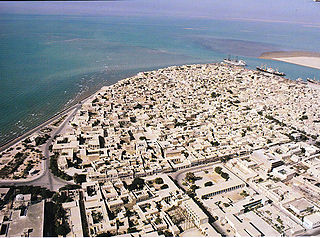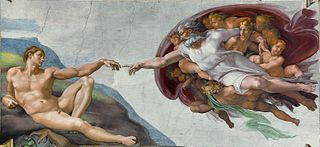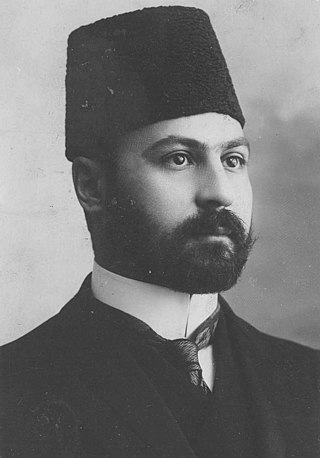
Persian, also known by its endonym Farsi or Parsi, is a Western Iranian language belonging to the Iranian branch of the Indo-Iranian subdivision of the Indo-European languages. Persian is a pluricentric language predominantly spoken and used officially within Iran, Afghanistan, and Tajikistan in three mutually intelligible standard varieties, respectively Iranian Persian, Dari Persian, and Tajiki Persian. It is also spoken natively in the Tajik variety by a significant population within Uzbekistan, as well as within other regions with a Persianate history in the cultural sphere of Greater Iran. It is written officially within Iran and Afghanistan in the Persian alphabet, a derivative of the Arabic script, and within Tajikistan in the Tajik alphabet, a derivative of the Cyrillic script.
Historical negationism, also called historical denialism, is falsification or distortion of the historical record. This is not the same as historical revisionism, a broader term that extends to newly evidenced, fairly reasoned academic reinterpretations of history. In attempting to revise the past, historical negationism acts as illegitimate historical revisionism by using techniques inadmissible in proper historical discourse, such as presenting known forged documents as genuine, inventing ingenious but implausible reasons for distrusting genuine documents, attributing conclusions to books and sources that report the opposite, manipulating statistical series to support the given point of view, and deliberately mistranslating texts.

Iran's ethnic diversity means that the languages of Iran come from a number of linguistic origins, although the primary language spoken and used is Persian. The Constitution of the Islamic Republic of Iran asserts that the Persian language alone must be used for schooling and for all official government communications. The constitution also recognizes Arabic as the language of Islam, and assigns it formal status as the language of religion. Although multilingualism is not encouraged, the use of minority languages is permitted in the course of teaching minority-language literature. Different publications have reported different statistics for the languages of Iran; however, the top three languages spoken are consistently reported as Persian, Azeri and Kurdish.

Sorani Kurdish, also known as Central Kurdish, is a Kurdish dialect or a language that is spoken in Iraq, mainly in Iraqi Kurdistan, as well as the provinces of Kurdistan, Kermanshah, and West Azerbaijan in western Iran. Sorani is one of the two official languages of Iraq, along with Arabic, and is in administrative documents simply referred to as "Kurdish".

A textbook is a book containing a comprehensive compilation of content in a branch of study with the intention of explaining it. Textbooks are produced to meet the needs of educators, usually at educational institutions. Schoolbooks are textbooks and other books used in schools. Today, many textbooks are published in both print and digital formats.

Bushehr Province is one of the 31 provinces of Iran. It is in the south of the country, with a long coastline on the Persian Gulf. The city of Bushehr is the provincial capital. At the 2006 census, the province's population was 886,490 in 188,762 households. The following census in 2011 counted 1,032,949 people in 246,742 households. By the time the 2016 census was conducted, the province's population had risen to 1,163,400 inhabitants in 321,826 households.
A hawza or ḥawzah ʿilmīyah is the collective term for madrasa where Shi'a Muslim scholars are educated.

The status of creation and evolution in public education has been the subject of substantial debate and conflict in legal, political, and religious circles. Globally, there are a wide variety of views on the topic. Most western countries have legislation that mandates only evolutionary biology is to be taught in the appropriate scientific syllabuses.

Education in Iran is centralized and divided into K-12 education plus higher education. Elementary and secondary education is supervised by the Ministry of Education and higher education is under the supervision of Ministry of Science, Research and Technology and Ministry of Health and Medical Education for medical sciences. As of 2016, around 86% of the Iranian adult population is literate. This rate increases to 97% among young adults ages between 15 and 24 without any gender consideration. By 2007, Iran had a student-to-workforce population ratio of 10.2%, standing among the countries with the highest ratio in the world.
Abul-Hasan Kūshyār ibn Labbān ibn Bashahri Daylami (971–1029), also known as Kūshyār Daylami, was an Iranian mathematician, geographer, and astronomer from Daylam, south of the Caspian Sea, Iran.
Churchill Livingstone is an academic publisher.

Shahab al-Din Abu Hafs Umar Suhrawardi was a Persian Sufi and nephew of Abu al-Najib Suhrawardi. He expanded the Sufi order of Suhrawardiyya that had been created by his uncle Abu al-Najib Suhrawardi, and is the person responsible for officially formalizing the order. Suhrawardi is the author of the ʿAwārif al-Maʿārif, which is recognized as a masterpiece work in Tasawwuf.
According to Circular 38a of the U.S. Copyright Office, Iran has no official copyright relations whatsoever with the United States.

Located in and around the Isfahan metro area, Iran, the American School Of Isfahan (ASI) was an international K-12 grade American School from 1973 through the end of 1978. Many of the school's teachers were from the United States or Europe. Its athletic teams competed against other international and western college preparatory schools in Iran, Egypt, and the UAE.
The Institute for Monitoring Peace and Cultural Tolerance in School Education (IMPACT-SE), formerly known as the Center for Monitoring the Impact of Peace (CMIP), is an Israeli non-profit organization that monitors the content of school textbooks, specifically how they educate in relation to religion, societies, cultures, democratic values and the 'Other'. It examines school curricula worldwide, to determine whether the material conforms to international standards as derived from UNESCO declarations and resolutions, advocating for change when necessary. The organization believes that education should be utilized to encourage tolerance, pluralism and democracy, and promote peaceful means of solving conflicts.
Kamaloddin Jenab was an Iranian pioneer physicist. He is often credited for founding academic experimental science in Iranian universities.
Dawūd al-Qayṣarī was an early Ottoman Sufi scholar, philosopher and mystic. He was born in Kayseri, in central Anatolia and was the student of the Iranian scholar, Abd al-Razzaq Kāshānī.

Hassan Pirnia, was a prominent Iranian politician of 20th-century Iran. He held a total of twenty-four posts during his political career, serving four times as Prime Minister of Iran. He was also a historian, co-founding the Society for the National Heritage of Iran.
The Organization for Researching and Composing University textbooks in the Humanities or SAMT* is a public organization and publisher in Iran established by the "High Council for Cultural Revolution" after the Iranian Cultural Revolution in 1985. The organization publishes academic textbooks and sources on humanities in Iranian universities.

The Republic of Mahabad, also referred to as the Republic of Kurdistan, was a short-lived Kurdish self-governing unrecognized state in present-day Iran, from 22 January to 15 December 1946. The Republic of Mahabad, a puppet state of the Soviet Union, arose alongside the Azerbaijan People's Government, a similarly short-lived unrecognized Soviet puppet state.











